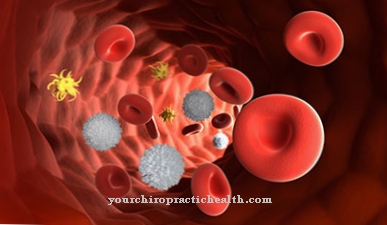The Amatoxin Syndrome is a life-threatening mushroom poisoning that occurs in the majority of cases after the ingestion of the death cap species. The toxins contained in these mushrooms can lead to liver and kidney failure, and amatoxin syndrome is fatal in around 10 percent of cases despite emergency medical care.
What is Amatoxin Syndrome?

Amatoxin syndrome is a complex of symptoms that occurs after poisoning by certain types of fungus that contain amanitins, which are highly toxic to the human organism.
The most common types of fungus that cause amatoxin syndrome in Europe include the green amanita mushroom (Amanita phalloides), the yellow amanita mushroom (Amanita citrina), the cone-capped amanita mushroom (Amanita virosa) and the white amanita mushroom (Amanita verna). After a latency period of around 6 to 24 hours, the first gastrointestinal symptoms manifest themselves in the form of colicky abdominal pain, vomiting and nausea, as well as leg cramps and watery diarrhea, which can lead to a dangerous loss of electrolytes and fluids (gastrointestinal phase).
After about 24 hours an apparent recovery phase occurs, in which, however, irreversible damage to internal organs, especially the liver and kidneys, has already set in. This hepatorenal phase is manifested by jaundice (jaundice), an increase in the enzymes typical of the liver, internal bleeding due to the falling concentration of coagulation factors, an increase in urinary substances, coma hepaticum and kidney failure.
causes
Amatoxin syndrome is caused by the ingestion of certain types of fungus that contain amanitins. The toxic effect is due to the fact that Amanitin attaches itself to the transcriptase, the so-called mRNA polymerase, and thus inhibits the transcription of the DNA into an RNA strand.
As a result of the missing RNA strand, no information from the nucleus (cell nucleus) reaches the cell plasma, where the ribosomes normally code amino acid sequences with the help of the RNA strand.This process is suppressed in the cells affected by Amatoxin syndrome. Since proteins (including hormones, enzymes) can no longer be synthesized and all processes in which these substances are involved fail, the entire cell metabolism (cellular metabolism) breaks down.
Already 0.1 mg / kg or 20 to 40 mg of the death cap mushroom are sufficient in an adult human for an amatoxin syndrome to be lethal.
Symptoms, ailments & signs
Typical signs of mushroom poisoning include nausea and vomiting, chills, fever, and impaired consciousness. In the gastrointestinal area, colic, watery diarrhea and cramps can occur, which increase in intensity in the first three to four hours after ingesting the toxin. You may also experience dizziness, sweating, and serious breathing difficulties such as shortness of breath.
Anatoxin syndrome is characteristic of the symptoms subsiding after about four to six hours. Then there is apparent relief, but this is quickly interrupted by serious, life-threatening symptoms. Those affected suffer kidney failure relatively quickly, which manifests itself as signs of jaundice: The skin turns yellow, the eye sockets collapse and sweating occurs.
This is accompanied by internal bleeding, which ultimately leads to anemia. Such bleeding anemia manifests itself as dizziness, tiredness and paleness. Furthermore, as a result of fungal poisoning, there is a breakdown of the entire cell metabolism, which is noticeable in a rapid decline in mental and physical performance. After six hours, the organs are usually irreversibly damaged. Those affected then fall into a coma and die of mushroom poisoning.
Diagnosis & course
In addition to the symptoms characteristic of amatoxin syndrome, the poisoning can be diagnosed in the laboratory by a pronounced decrease in antithrombin III. In addition, periportal inflammatory infiltrates and centrolobular necroses (located in the middle of the liver lobe) can be detected histologically in the liver.
In addition, a determination of the alpha-amanitin concentration in the urine and a so-called lignin test, in which the suspicious fungus is tested on lignin-containing paper for amatoxins (blue-green color), can be indicated.
The amatoxin syndrome is one of the most dangerous fungal infections due to the comparatively long latency period of over four hours in which the toxic substances can spread in the body. Correspondingly, around 10 percent of the cases of poisoning with Amanitin show a lethal course despite emergency medical care.
Complications
The amatoxin syndrome is associated with life-threatening complications which, in the worst case, can lead to the death of the patient if countermeasures against the tuber poisoning are not initiated in good time. The highly toxic amantines of the tuber mushrooms cause gastrointestinal complaints such as colicky stomach pain, vomiting, nausea and watery diarrhea. These can lead to a life-threatening loss of fluids and electrolytes.
Other accompanying symptoms are chills, palpitations, shortness of breath, dizziness, sweating and impaired consciousness. The latency period is six to 24 hours. After that, there is an apparent relief that many patients equate with symptom resolution and recovery. In fact, in this phase, irreversible damage to organs such as the liver and kidneys occurs.
This part of the course of the disease is known as the hepatorental phase, which manifests itself in an increase in enzymes typical of the liver, internal bleeding, jaundice, a reduced concentration of coagulation factors, an increase in urinary substances, coma hapaticum and kidney failure. The tuber poisoning leads to a breakdown of the entire cell metabolism (cellular metabolism), since proteins such as enzymes and hormones are no longer synthesized.
Patients with amatoxin syndrome are a medical emergency because the comparatively long latency period of up to six hours during which the toxic substances can spread in the body, the chances of survival are comparatively low. In around ten percent of patients, despite timely treatment, the state of health deteriorates to such an extent that the tuber poisoning becomes fatal.
When should you go to the doctor?
Amatoxin syndrome must definitely be treated by a doctor. If the syndrome is not treated promptly, in most cases the patient will die directly from the serious poisoning. If the person concerned suffers from the symptoms of amatoxin syndrome after consuming mushrooms, treatment by a doctor must urgently be carried out. Usually either the emergency doctor has to be called or a hospital has to be visited directly. Most of those affected suffer from vomiting, nausea and diarrhea.
The stomach and stomach are extremely painful and dizziness occurs. Furthermore, impaired consciousness or shortness of breath can indicate the complaint. It is not uncommon for a rapid heartbeat and panic attacks to occur. If these symptoms occur, a doctor must be consulted immediately and treatment started. However, in some cases the patient may die even with treatment.
In many cases, the patient's condition with amatoxin syndrome improves in a few hours. However, since the organs are still damaged, a visit to the doctor is essential.
Doctors & therapists in your area
Treatment & Therapy
Amatoxin syndrome is life-threatening fungal poisoning and represents a medical emergency. In the early stages of amatoxin syndrome, primary poison elimination or gastric emptying through mechanical irritation may be indicated.
Continuous application of medicinal charcoal (activated charcoal) can reduce the enterohepatic (affecting the intestinal-liver circulation) toxin circulation and stimulate the excretion of the toxin from the organism. In order to prevent desiccosis and hypovolemic shock from persistent watery diarrhea, compensation for the loss of electrolytes and fluids is also indicated.
In addition, silibinin, an active ingredient contained in milk thistle, should be infused as soon as possible in order to inhibit the infiltration of Amanitin into the liver cells. The falling antithrombin III concentration can also be compensated for as part of a substitution therapy or administration of fresh frozen plasma.
Haemoperfusion can be used to remove the toxins that cause amatoxin syndrome extracorporeally from the blood. Here, the blood of the person concerned is passed through a column in which there is, for example, activated carbon that binds the toxins and removes them from the bloodstream accordingly.
This procedure is usually used when hemodialysis (extracorporeal blood washing) has not been able to eliminate the triggering toxins to a sufficient extent. If the liver is severely damaged, a liver transplant is indicated in amatoxin syndrome.
Outlook & forecast
In the worst case, the amatoxin syndrome can lead to death of the patient. Urgent treatment by a doctor is necessary to prevent kidney and liver failure. With amatoxin syndrome, those affected suffer from the usual symptoms of poisoning.
This leads to diarrhea and vomiting, with most patients also suffering from severe pain in the stomach and abdomen. Furthermore, sweats can occur and those affected feel sick and exhausted. The chills and palpitations develop. Furthermore, the patient can also lose consciousness.
Should the Amatoxin syndrome occur, the emergency doctor must usually be called directly. A detox is carried out to save the person concerned. The patient is also still dependent on bed rest and recovery and suffers from a greatly reduced resilience. In most cases, the symptoms of this poisoning can be remedied relatively easily if treatment is started early. If the amatoxin syndrome has severely damaged the liver or kidneys, a transplant may also be necessary.
prevention
Amatoxin syndrome can be prevented by avoiding ingestion of types of fungus that contain the toxin amanitin. Accordingly, inexperienced mushroom pickers should completely refrain from collecting and consuming unknown mushroom varieties in order to rule out mushroom poisoning and, accordingly, a life-threatening amatoxin syndrome.
Aftercare
In most cases, patients with amatoxin syndrome do not have any special aftercare options. In the foreground is the treatment of the disease in order to prevent a fatal course. In some cases, the patient's life expectancy is also significantly reduced as a result of the syndrome. With amatoxin syndrome, the person affected is dependent on taking medication.
These should be taken regularly, paying attention to the interaction with other medications. An early diagnosis and treatment of the syndrome have a very positive effect on the further course and can prevent complications or even a fatal course. However, the poisoning can damage a person's liver so badly that a transplant is necessary to keep the person alive.
If the first signs of Amatoxin syndrome appear, an emergency doctor must be called immediately or the hospital must be visited directly. After a successful treatment, the patient has to rest and take care of his body. Physical exertion or sporting activities should be avoided. Likewise, only light food should be taken at the beginning in order not to overload the digestion. If the amatoxin syndrome is successfully treated, the patient's life expectancy is usually not reduced.
You can do that yourself
Amatoxin syndrome is usually triggered by consuming the highly poisonous death cap mushroom. If poisoning is suspected, the stomach contents should first be vomited and an emergency doctor should be consulted immediately. The emergency services must be informed about the circumstances of the poisoning, the symptoms and the constitution of the patient based on the W questions. In addition, if possible, a piece of the fungus should be kept ready to enable a quick diagnosis.
The person affected should be placed on their side and warmed with blankets until the ambulance service arrives. If necessary, resuscitation measures must be carried out. In the meantime, those affected can determine the syndrome based on the clear symptoms. Severe colicky stomach pain and other gastrointestinal complaints point to the amatoxin syndrome.
The most effective self-measure, in addition to alerting the emergency services, is vomiting the mushroom you have eaten. Even if this succeeds, the inevitable second phase of the disease (hepatorenal phase) must be cured in a hospital. After recovery, physical rest and bed rest are recommended. Depending on whether and which organs the amatoxin syndrome has damaged, further therapeutic measures must be worked out together with the responsible doctor.




.jpg)

.jpg)




















